- Joined
- Oct 9, 2007
- Messages
- 47,164 (7.57/day)
- Location
- Hyderabad, India
| System Name | RBMK-1000 |
|---|---|
| Processor | AMD Ryzen 7 5700G |
| Motherboard | ASUS ROG Strix B450-E Gaming |
| Cooling | DeepCool Gammax L240 V2 |
| Memory | 2x 8GB G.Skill Sniper X |
| Video Card(s) | Palit GeForce RTX 2080 SUPER GameRock |
| Storage | Western Digital Black NVMe 512GB |
| Display(s) | BenQ 1440p 60 Hz 27-inch |
| Case | Corsair Carbide 100R |
| Audio Device(s) | ASUS SupremeFX S1220A |
| Power Supply | Cooler Master MWE Gold 650W |
| Mouse | ASUS ROG Strix Impact |
| Keyboard | Gamdias Hermes E2 |
| Software | Windows 11 Pro |
AMD today announced the Ryzen 8000G line of desktop APUs. These come in the Socket AM5 package, and are supported by all motherboards based on the AMD X670/E, B650/E, and A620 chipsets, with some requiring UEFI firmware updates. Since USB BIOS Flashback is standard issue on AMD motherboards, this should be no problem. With Ryzen 7000 series "Raphael" desktop processors that debut the "Zen 4" microarchitecture, AMD had standardized integrated graphics, however, the iGPU for these are just enough for desktop/productivity workloads, offering comparable performance to the iGPUs of Intel 13th Gen Core desktop processors. AMD doesn't consider Ryzen 7000 chips as APUs for this reason. An APU has to be a processor with powerful integrated graphics that can offer entry-level gaming, high-res content consumption, or multi-monitor productivity, and "Raphael" isn't it. Enter the Ryzen 8000G series.
The AMD Ryzen 8000G series debuts four APU models, the Ryzen 7 8700G, the Ryzen 5 8600G, the Ryzen 5 8500G, and the Ryzen 3 8300G. The 8700G and 8600G are based on the 4 nm "Hawk Point" silicon, feature Ryzen AI, and are the first desktop processors to feature an NPU (neural processing unit). The 8500G and 8300G are based on the 4 nm "Phoenix 2" silicon. The Ryzen 7 8700G leads the pack, and is a maxed out implementation of "Hawk Point," featuring an 8-core/16-thread CPU based on the "Zen 4" microarchitecture, the full Radeon 780M integrated graphics implementation with 12 RDNA3 compute units; and the Ryzen AI XDNA NPU. The processor has a combined AI throughput of 39 TOPS, with 16 TOPS from the NPU. For reference, an Intel Core Ultra 7 165H "Meteor Lake" mobile processor with its AI Boost NPU, has a combined AI throughput of 34 TOPS.

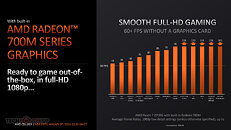


The 8-core/16-thread CPU of the 8700G is clocked at 4.20 GHz base, and 5.10 GHz maximum boost frequency. Each of its eight cores has 1 MB of L2 cache, and the eight share a 16 MB L3 cache. The Radeon 780M iGPU has an engine boost frequency of 2.90 GHz. This iGPU is configured with 12 compute units that make up 768 stream processors, 24 AI accelerators, 12 Ray accelerators, 48 TMUs, and 32 ROPs. The processor comes with a 65 W TDP, and its retail PIB (processor in box) package includes a Wraith Spire cooling solution that's originally designed for 95 W TDP processors.
It's important to note here, that the AI accelerators intrinsic to the CU are different from the purpose-built NPU. An RDNA 3 AI accelerator is a fixed function component that prepares matrix math workloads for processing on the SIMD units of the CU. The "Zen 4" CPU cores are capable of a truncated, client-relevant set of AVX-512 VNNI instructions using their dual-pumped 256-bit FPUs, and features support for Bfloat16—instructions relevant to AI workloads. The combination of "Zen 4" CPU cores, the RDNA3 iGPU, and the purpose-built Ryzen AI XDNA NPU, is how AMD arrives at the combined throughput figure of 39 TOPS. The NPU is a power-efficient way to deal with AI deep-learning neural net building and training.
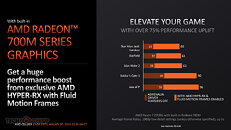

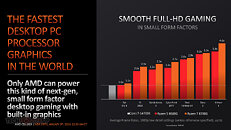
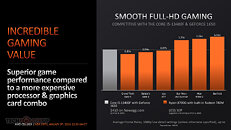
The Ryzen 5 8600G is based on the same "Hawk Point" silicon as the 8700G, but comes with a 6-core/12-thread "Zen 4" CPU clocked at 4.35 GHz base, and 5.00 GHz boost. Each of the 6 cores has 1 MB of L2 cache, and share the full 16 MB L3 cache available on the silicon. This processor model gets the Radeon 760M integrated graphics. The 760M is configured with 8 compute units, which work out to 512 stream processors, 16 AI accelerators, 8 Ray accelerators, 32 TMUs, and 16 ROPs. AMD has given it a maximum engine boost frequency of 2.80 GHz. The 8600G gets the same NPU as the 8700G, with an identical 16 TOPS throughput. The processor has the same 65 W TDP, and AMD will include a Wraith Spire cooler in the PIB retail package.
Things get interesting with the 8500G and 8300G. These are not based on 178 mm² "Hawk Point" silicon, but rather the smaller 137 mm² "Phoenix 2." This chip physically features a 6-core CPU, but from these, two are "Zen 4" cores, while the other four are "Zen 4c," making this AMD's first crack at a hybrid processor. The "Zen 4c" core is physically smaller than "Zen 4," and was originally designed for the high-density 128-core EPYC "Bergamo" server processor. Despite being physically smaller, it has identical numbers of core components as "Zen 4," and hence has an identical IPC and instruction set as "Zen 4," as well as SMT, however, it has much tighter vCore limits, which means that these cores have a lower boost frequency than the "Zen 4" cores. AMD marks the "Zen 4" cores as UEFI CPPC "preferred cores," which tells the OS to prioritize workloads to them, as they can hold on to the highest boost frequencies.
It's not just the 6-core CPU, the "Phoenix 2" silicon also lacks an NPU, which means that the 8500G and 8300G miss out on Ryzen AI. The silicon also features a smaller Radeon 740M iGPU, which physically only has 4 compute units, amounting to 256 stream processors, 8 AI accelerators, 4 Ray accelerators, 16 TMUs, and 8 ROPs. AMD has given this an engine boost frequency of 2.80 GHz on both the 8500G and 8300G.
The Ryzen 5 8500G technically has a 6-core/12-thread CPU, but two of these cores are "Zen 4," and the other four "Zen 4c." each of the six has a 1 MB L2 cache, and interestingly, all six share a common 16 MB L3 cache. This is a monolithic cache, and is not a case of two CCX having an 8 MB L3 cache, each. A common L3 cache between the "Zen 4" and "Zen 4c" cores should greatly speed up movement of workloads between the two kinds of cores. The Ryzen 5 8500G CPU has a base frequency of 3.50 GHz, with a maximum boost frequency of 5.00 GHz (attainable only by the "Zen 4" cores). AMD hasn't put out the maximum boost frequency of the "Zen 4c" cores, yet. The retail PIB package of the 8500G will include a Wraith Stealth cooler, a compacted version of the Wraith Spire, designed for 65 W processors.
The Ryzen 3 8300G is an entry-level chip that AMD isn't releasing in the retail channel, but rather only through its prebuilt desktop OEM partners. This one gets a 4-core CPU, but only one of the four cores is "Zen 4," the other three are "Zen 4c." The CPU base frequency is 3.40 GHz, and the maximum boost frequency is 4.90 GHz (again, only attainable by the sole "Zen 4" core). The 8300G gets the same Radeon 740M iGPU as the 8500G, with an identical 2.80 GHz. It gets the same 65 W TDP. While not available in the retail channel, you can expect brick and mortar stores in some markets to have trays of these chips under their counters to sell as processor+motherboard+RAM bundles.
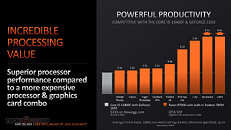
Hardware specs are only half the story, the 8700G and 8600G are claimed to offer phenomenal entry-level gaming performance, as they fully support the AMD HyperRX frame-rate speedups, including Fluid Motion Frames. Even without HyperRX, at 1080p, the Radeon 780M is shown offering playable 23-58 FPS in popular titles such as "Jedi Survivor," "Starfield," "Alan Wake 2," "Baldur's Gate 3," and "Lies of P," with HyperRX more than doubling frame rates in these games to around 60 FPS. AMD claims that the 8700G at its price will offer a superior alternative to a similarly priced combination of a Core i5-13400F processor and an entry-level discrete GPU.
As a CPU, the 8700G and 8600G offer comparable performance levels to the Ryzen 7 7700 and Ryzen 7 7600, respectively. The new chips have smaller L3 caches, but should benefit from lower memory latencies across the pipeline, as "Hawk Point" is a monolithic chip. The reference memory standard supported is dual-channel DDR5-5600, although memory overclocking is very much possible. Historically, AMD's desktop APUs based on monolithic chips have been good at memory overclocking. Both these chips very much do support AMD EXPO memory modules, for easy memory overclocking. Both the 8700G and 8600G come with unlocked multipliers for the CPU, so you can play around within the available power limits.
The "Hawk Point" silicon physically lacks PCI-Express Gen 5 capability, and so when installed on any Socket AM5 motherboard, the Gen 5-capable x16 and M.2 slots will run in Gen 4 mode. Also, since the "Hawk Point" SoC only puts out a maximum of 24 PCIe lanes, on motherboards with two CPU-attached M.2 NVMe slots, one of the slot will be disabled.
All Ryzen 8000G series APUs being announced today will be available from January 31. The 8700G is priced at USD $329, the 8600G at $229, and the 8500G at $179.
View at TechPowerUp Main Site
The AMD Ryzen 8000G series debuts four APU models, the Ryzen 7 8700G, the Ryzen 5 8600G, the Ryzen 5 8500G, and the Ryzen 3 8300G. The 8700G and 8600G are based on the 4 nm "Hawk Point" silicon, feature Ryzen AI, and are the first desktop processors to feature an NPU (neural processing unit). The 8500G and 8300G are based on the 4 nm "Phoenix 2" silicon. The Ryzen 7 8700G leads the pack, and is a maxed out implementation of "Hawk Point," featuring an 8-core/16-thread CPU based on the "Zen 4" microarchitecture, the full Radeon 780M integrated graphics implementation with 12 RDNA3 compute units; and the Ryzen AI XDNA NPU. The processor has a combined AI throughput of 39 TOPS, with 16 TOPS from the NPU. For reference, an Intel Core Ultra 7 165H "Meteor Lake" mobile processor with its AI Boost NPU, has a combined AI throughput of 34 TOPS.




The 8-core/16-thread CPU of the 8700G is clocked at 4.20 GHz base, and 5.10 GHz maximum boost frequency. Each of its eight cores has 1 MB of L2 cache, and the eight share a 16 MB L3 cache. The Radeon 780M iGPU has an engine boost frequency of 2.90 GHz. This iGPU is configured with 12 compute units that make up 768 stream processors, 24 AI accelerators, 12 Ray accelerators, 48 TMUs, and 32 ROPs. The processor comes with a 65 W TDP, and its retail PIB (processor in box) package includes a Wraith Spire cooling solution that's originally designed for 95 W TDP processors.
It's important to note here, that the AI accelerators intrinsic to the CU are different from the purpose-built NPU. An RDNA 3 AI accelerator is a fixed function component that prepares matrix math workloads for processing on the SIMD units of the CU. The "Zen 4" CPU cores are capable of a truncated, client-relevant set of AVX-512 VNNI instructions using their dual-pumped 256-bit FPUs, and features support for Bfloat16—instructions relevant to AI workloads. The combination of "Zen 4" CPU cores, the RDNA3 iGPU, and the purpose-built Ryzen AI XDNA NPU, is how AMD arrives at the combined throughput figure of 39 TOPS. The NPU is a power-efficient way to deal with AI deep-learning neural net building and training.




The Ryzen 5 8600G is based on the same "Hawk Point" silicon as the 8700G, but comes with a 6-core/12-thread "Zen 4" CPU clocked at 4.35 GHz base, and 5.00 GHz boost. Each of the 6 cores has 1 MB of L2 cache, and share the full 16 MB L3 cache available on the silicon. This processor model gets the Radeon 760M integrated graphics. The 760M is configured with 8 compute units, which work out to 512 stream processors, 16 AI accelerators, 8 Ray accelerators, 32 TMUs, and 16 ROPs. AMD has given it a maximum engine boost frequency of 2.80 GHz. The 8600G gets the same NPU as the 8700G, with an identical 16 TOPS throughput. The processor has the same 65 W TDP, and AMD will include a Wraith Spire cooler in the PIB retail package.
Things get interesting with the 8500G and 8300G. These are not based on 178 mm² "Hawk Point" silicon, but rather the smaller 137 mm² "Phoenix 2." This chip physically features a 6-core CPU, but from these, two are "Zen 4" cores, while the other four are "Zen 4c," making this AMD's first crack at a hybrid processor. The "Zen 4c" core is physically smaller than "Zen 4," and was originally designed for the high-density 128-core EPYC "Bergamo" server processor. Despite being physically smaller, it has identical numbers of core components as "Zen 4," and hence has an identical IPC and instruction set as "Zen 4," as well as SMT, however, it has much tighter vCore limits, which means that these cores have a lower boost frequency than the "Zen 4" cores. AMD marks the "Zen 4" cores as UEFI CPPC "preferred cores," which tells the OS to prioritize workloads to them, as they can hold on to the highest boost frequencies.
It's not just the 6-core CPU, the "Phoenix 2" silicon also lacks an NPU, which means that the 8500G and 8300G miss out on Ryzen AI. The silicon also features a smaller Radeon 740M iGPU, which physically only has 4 compute units, amounting to 256 stream processors, 8 AI accelerators, 4 Ray accelerators, 16 TMUs, and 8 ROPs. AMD has given this an engine boost frequency of 2.80 GHz on both the 8500G and 8300G.
The Ryzen 5 8500G technically has a 6-core/12-thread CPU, but two of these cores are "Zen 4," and the other four "Zen 4c." each of the six has a 1 MB L2 cache, and interestingly, all six share a common 16 MB L3 cache. This is a monolithic cache, and is not a case of two CCX having an 8 MB L3 cache, each. A common L3 cache between the "Zen 4" and "Zen 4c" cores should greatly speed up movement of workloads between the two kinds of cores. The Ryzen 5 8500G CPU has a base frequency of 3.50 GHz, with a maximum boost frequency of 5.00 GHz (attainable only by the "Zen 4" cores). AMD hasn't put out the maximum boost frequency of the "Zen 4c" cores, yet. The retail PIB package of the 8500G will include a Wraith Stealth cooler, a compacted version of the Wraith Spire, designed for 65 W processors.
The Ryzen 3 8300G is an entry-level chip that AMD isn't releasing in the retail channel, but rather only through its prebuilt desktop OEM partners. This one gets a 4-core CPU, but only one of the four cores is "Zen 4," the other three are "Zen 4c." The CPU base frequency is 3.40 GHz, and the maximum boost frequency is 4.90 GHz (again, only attainable by the sole "Zen 4" core). The 8300G gets the same Radeon 740M iGPU as the 8500G, with an identical 2.80 GHz. It gets the same 65 W TDP. While not available in the retail channel, you can expect brick and mortar stores in some markets to have trays of these chips under their counters to sell as processor+motherboard+RAM bundles.

Hardware specs are only half the story, the 8700G and 8600G are claimed to offer phenomenal entry-level gaming performance, as they fully support the AMD HyperRX frame-rate speedups, including Fluid Motion Frames. Even without HyperRX, at 1080p, the Radeon 780M is shown offering playable 23-58 FPS in popular titles such as "Jedi Survivor," "Starfield," "Alan Wake 2," "Baldur's Gate 3," and "Lies of P," with HyperRX more than doubling frame rates in these games to around 60 FPS. AMD claims that the 8700G at its price will offer a superior alternative to a similarly priced combination of a Core i5-13400F processor and an entry-level discrete GPU.
As a CPU, the 8700G and 8600G offer comparable performance levels to the Ryzen 7 7700 and Ryzen 7 7600, respectively. The new chips have smaller L3 caches, but should benefit from lower memory latencies across the pipeline, as "Hawk Point" is a monolithic chip. The reference memory standard supported is dual-channel DDR5-5600, although memory overclocking is very much possible. Historically, AMD's desktop APUs based on monolithic chips have been good at memory overclocking. Both these chips very much do support AMD EXPO memory modules, for easy memory overclocking. Both the 8700G and 8600G come with unlocked multipliers for the CPU, so you can play around within the available power limits.
The "Hawk Point" silicon physically lacks PCI-Express Gen 5 capability, and so when installed on any Socket AM5 motherboard, the Gen 5-capable x16 and M.2 slots will run in Gen 4 mode. Also, since the "Hawk Point" SoC only puts out a maximum of 24 PCIe lanes, on motherboards with two CPU-attached M.2 NVMe slots, one of the slot will be disabled.
All Ryzen 8000G series APUs being announced today will be available from January 31. The 8700G is priced at USD $329, the 8600G at $229, and the 8500G at $179.
View at TechPowerUp Main Site



